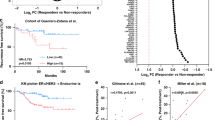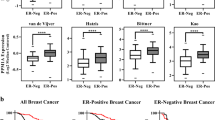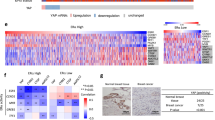Abstract
Progesterone regulates the proliferation and differentiation of normal mammary epithelium. In breast cancer cells, progesterone and its synthetic analogs, progestins, induce long-term growth inhibition and differentiation. However, the mechanisms responsible are not fully understood. When T-47D breast cancer cells were treated with the synthetic progestin ORG 2058 (16α-ethoxy-21-hydroxy-19-norpregn-4-en-3,20-dione), all isoforms of Wilms' tumor protein 1 (Wt1) mRNA and protein were rapidly downregulated. We reasoned that the decrease in Wt1 levels may contribute to the long-term antiproliferative and differentiative effects of progestins as proliferation and differentiation are known end points of Wt1 action. Consistent with this idea, Wt1 small interfering RNA led to a decrease in S phase and cyclin D1 levels, and increased Oil-Red-O staining, indicating increased lipogenesis. Conversely, overexpression of Wt1 attenuated the decrease in S phase induced by ORG 2058 at 48–96 h. This was accompanied by the sustained expression of cyclin D1 despite progestin treatment, and increased levels of retinoblastoma (Rb) phosphorylation at sites targeted by cyclin D1-Cdk4 (Ser249/Thr252). Wt1 overexpression also attenuated the ORG 2058-mediated increase in fatty acid synthase levels and reduced lipogenesis. Thus, Wt1 downregulation was sufficient to mimic the effects of progestin and was necessary for complete progestin-mediated proliferative arrest and subsequent differentiation. Furthermore, Wt1 overexpression modulated the effects of progestins but not anti-estrogens or androgens. These results indicate that Wt1 is an important early target of progestins that regulates both proliferation and differentiation in breast cancer cells.
This is a preview of subscription content, access via your institution
Access options
Subscribe to this journal
Receive 50 print issues and online access
$259.00 per year
only $5.18 per issue
Buy this article
- Purchase on Springer Link
- Instant access to full article PDF
Prices may be subject to local taxes which are calculated during checkout







Similar content being viewed by others
References
Anthony FW, Mukhtar DD, Pickett MA, Cameron IT . (2003). Progesterone up-regulates WT1 mRNA and protein, and alters the relative expression of WT1 transcripts in cultured endometrial stromal cells. J Soc Gynecol Investig 10: 509–516.
Baudry D, Hamelin M, Cabanis M-O, Fournet J-C, Tournade M-F, Sarnacki S et al. (2000). WT1 splicing alterations in Wilms' tumors. Clin Cancer Res 6: 3957–3965.
Bray JD, Jelinsky S, Ghatge R, Bray JA, Tunkey C, Saraf K et al. (2005). Quantitative analysis of gene regulation by seven clinically relevant progestins suggests a highly similar mechanism of action through progesterone receptors in T47D breast cancer cells. J Steroid Biochem Mol Biol 97: 328–341.
Burwell EA, McCarty GP, Simpson LA, Thompson KA, Loeb DM . (2007). Isoforms of Wilms' tumor suppressor gene (WT1) have distinct effects on mammary epithelial cells. Oncogene 26: 3423–3430.
Castro-Rivera E, Samudio I, Safe S, Yan YX, Nakagawa H, Lee MH et al. (2001). Estrogen regulation of cyclin D1 gene expression in ZR-75 breast cancer cells involves multiple enhancer elements. J Biol Chem 276: 30853–30861.
Chambon M, Rochefort H, Vial HJ, Chalbos D . (1989). Progestins and androgens stimulate lipid accumulation in T47D breast cancer cells via their own receptors. J Steroid Biochem 33: 915–922.
Englert C, Maheswaran S, Garvin AJ, Kreidberg J, Haber DA . (1997). Induction of p21 by the Wilms' tumor suppressor gene WT1. Cancer Res 57: 1429–1434.
Fu M, Wang C, Li Z, Sakamaki T, Pestell RG . (2004). Minireview: Cyclin D1: normal and abnormal functions. Endocrinology 145: 5439–5447.
Graham JD, Yager ML, Hill HD, Byth K, O'Neill GM, Clarke CL . (2005). Altered progesterone receptor isoform expression remodels progestin responsiveness of breast cancer cells. Mol Endocrinol 19: 2713–2735.
Groshong SD, Owen GI, Grimison B, Schauer IE, Todd MC, Langan TA et al. (1997). Biphasic regulation of breast cancer cell growth by progesterone: role of the cyclin-dependent kinase inhibitors, p21 and p27Kip1. Mol Endocrinol 11: 1593–1607.
Haber DA, Sohn RL, Buckler AJ, Pelletier J, Call KM, Housman DE . (1991). Alternative splicing and genomic structure of the Wilms' tumor gene WT1. Proc Natl Acad Sci USA 88: 9618–9622.
Han Y, San-Marina S, Liu J, Minden MD . (2004). Transcriptional activation of c-myc proto-oncogene by WT1 protein. Oncogene 23: 6933–6941.
Horton JD, Goldstein JL, Brown MS . (2002). SREBPs: activators of the complete program of cholesterol and fatty acid synthesis in the liver. J Clin Invest 109: 1125–1131.
Hui R, Finney GL, Carroll JS, Lee CS, Musgrove EA, Sutherland RL . (2002). Constitutive overexpression of cyclin D1 but not cyclin E confers acute resistance to antiestrogens in T-47D breast cancer cells. Cancer Res 62: 6916–6923.
Jomgeow T, Oji Y, Tsuji N, Ikeda Y, Ito K, Tsuda A et al. (2006). Wilms' tumor gene WT1 17AA(-)/KTS(-) isoform induces morphological changes and promotes cell migration and invasion in vitro. Cancer Sci 97: 259–270.
Kester HA, van der Leede B-jM, van der Saag PT, van der Burg B . (1997). Novel progesterone target genes identified by an improved differential display technique suggest that progestin-induced growth inhibition of breast cancer cells coincides with enhancement of differentiation. J Biol Chem 272: 16637–16643.
Kudoh T, Ishidate T, Moriyama M, Toyoshima K, Akiyama T . (1995). G1 phase arrest induced by Wilms tumor protein WT1 is abrogated by cyclin/CDK complexes. Proc Natl Acad Sci USA 92: 4517–4521.
Lee SB, Haber DA . (2001). Wilms tumor and the WT1 gene. Exp Cell Res 264: 74–99.
Lee TH, Moffett P, Pelletier J . (1999). The Wilms' tumor suppressor gene (wt1) product represses different functional classes of transcriptional activation domains. Nucleic Acids Res 27: 2889–2897.
Loeb DM, Evron E, Patel CB, Sharma PM, Niranjan B, Buluwela L et al. (2001). Wilms' tumor suppressor gene (WT1) is expressed in primary breast tumors despite tumor-specific promoter methylation. Cancer Res 61: 921–925.
Loeb DM, Korz D, Katsnelson M, Burwell EA, Friedman AD, Sukumar S . (2002). Cyclin E is a target of WT1 transcriptional repression. J Biol Chem 277: 19627–19632.
Loeb DM, Sukumar S . (2002). The role of WT1 in oncogenesis: tumor suppressor or oncogene? Int J Hematol 76: 117–126.
Martel PM, Bingham CM, McGraw CJ, Baker CL, Morganelli PM, Meng ML et al. (2006). S14 protein in breast cancer cells: direct evidence of regulation by SREBP-1c, superinduction with progestin, and effects on cell growth. Exp Cell Res 312: 278–288.
Miyoshi Y, Ando A, Egawa C, Taguchi T, Tamaki Y, Tamaki H et al. (2002). High expression of Wilms' tumor suppressor gene predicts poor prognosis in breast cancer patients. Clin Cancer Res 8: 1167–1171.
Musgrove EA, Lee CSL, Buckley MF, Sutherland RL . (1994). Cyclin D1 induction in breast cancer cells shortens G1 and is sufficient for cells arrested in G1 to complete the cell cycle. Proc Natl Acad Sci USA 91: 8022–8026.
Musgrove EA, Hamilton JA, Lee CS, Sweeney KJ, Watts CK, Sutherland RL . (1993). Growth factor, steroid, and steroid antagonist regulation of cyclin gene expression associated with changes in T-47D human breast cancer cell cycle progression. Mol Cell Biol 13: 3577–3587.
Musgrove EA, Hunter LJ, Lee CS, Swarbrick A, Hui R, Sutherland RL . (2001). Cyclin D1 overexpression induces progestin resistance in T-47D breast cancer cells despite p27(Kip1) association with cyclin E-Cdk2. J Biol Chem 276: 47675–47683.
Musgrove EA, Lee CS, Sutherland RL . (1991). Progestins both stimulate and inhibit breast cancer cell cycle progression while increasing expression of transforming growth factor alpha, epidermal growth factor receptor, c-fos, and c-myc genes. Mol Cell Biol 11: 5032–5043.
Musgrove EA, Lilischkis R, Cornish AL, Lee CS, Setlur V, Seshadri R et al. (1995). Expression of the cyclin-dependent kinase inhibitors p16INK4, p15INK4B and p21WAF1/CIP1 in human breast cancer. Int J Cancer 63: 584–591.
Musgrove EA, Swarbrick A, Lee CS, Cornish AL, Sutherland RL . (1998). Mechanisms of cyclin-dependent kinase inactivation by progestins. Mol Cell Biol 18: 1812–1825.
Nakatsuka S, Oji Y, Horiuchi T, Kanda T, Kitagawa M, Takeuchi T et al. (2006). Immunohistochemical detection of WT1 protein in a variety of cancer cells. Mod Pathol 19: 804–814.
Oji Y, Ogawa H, Tamaki H, Oka Y, Tsuboi A, Kim EH et al. (1999). Expression of the Wilms' tumor gene WT1 in solid tumors and its involvement in tumor cell growth. Jpn J Cancer Res 90: 194–204.
Ormandy CJ, Clarke CL, Kelly PA, Sutherland RL . (1992). Androgen regulation of prolactin-receptor gene expression in MCF-7 and MDA-MB-453 human breast cancer cells. Int J Cancer 50: 777–782.
Rae FK, Martinez G, Gillinder KR, Smith A, Shooter G, Forrest AR et al. (2004). Analysis of complementary expression profiles following WT1 induction versus repression reveals the cholesterol/fatty acid synthetic pathways as a possible major target of WT1. Oncogene 23: 3067–3079.
Ramírez-Zacarías JL, Castro-Muñozledo F, Kuri-Harcuch W . (1992). Quantitation of adipose conversion and triglycerides by staining intracytoplasmic lipids with Oil Red O. Histochemistry 97: 493–497.
Reizner N, Maor S, Sarfstein R, Abramovitch S, Welshons WV, Curran EM et al. (2005). The WT1 Wilms' tumor suppressor gene product interacts with estrogen receptor-alpha and regulates IGF-I receptor gene transcription in breast cancer cells. J Mol Endocrinol 35: 135–144.
Sakamaki T, Casimiro MC, Ju X, Quong AA, Katiyar S, Liu M et al. (2006). Cyclin D1 determines mitochondrial function in vivo. Mol Cell Biol 26: 5449–5469.
Scharnhorst V, van der Eb AJ, Jochemsen AG . (2001). WT1 proteins: functions in growth and differentiation. Gene 273: 141–161.
Siehl JM, Reinwald M, Heufelder K, Menssen HD, Keilholz U, Thiel E . (2004). Expression of Wilms' tumor gene 1 at different stages of acute myeloid leukemia and analysis of its major splice variants. Ann Hematol 83: 745–750.
Silberstein GB, Dressler GR, Van Horn K . (2002). Expression of the PAX2 oncogene in human breast cancer and its role in progesterone-dependent mammary growth. Oncogene 21: 1009–1016.
Silberstein GB, Van Horn K, Strickland P, Roberts Jr CT, Daniel CW . (1997). Altered expression of the WT1 Wilms tumor suppressor gene in human breast cancer. Proc Natl Acad Sci USA 94: 8132–8137.
Sutherland RL, Prall OW, Watts CK, Musgrove EA . (1998). Estrogen and progestin regulation of cell cycle progression. J Mammary Gland Biol Neoplasia 3: 63–72.
Swarbrick A, Lee CS, Sutherland RL, Musgrove EA . (2000). Cooperation of p27(Kip1) and p18(INK4c) in progestin-mediated cell cycle arrest in T-47D breast cancer cells. Mol Cell Biol 20: 2581–2591.
Sweeney KJ, Swarbrick A, Sutherland RL, Musgrove EA . (1998). Lack of relationship between CDK activity and G1 cyclin expression in breast cancer cells. Oncogene 16: 2865–2878.
Tuna M, Chavez-Reyes A, Tari AM . (2005). HER2/neu increases the expression of Wilms' tumor 1 (WT1) protein to stimulate S-phase proliferation and inhibit apoptosis in breast cancer cells. Oncogene 24: 1648–1652.
Wagner K-D, Wagner N, Vidal VP, Schley G, Wilhelm D, Schedl A et al. (2002). The Wilms' tumor gene Wt1 is required for normal development of the retina. EMBO J 21: 1398–1405.
Wagner N, Wagner K-D, Hammes A, Kirschner KM, Vidal VP, Schedl A et al. (2005). A splice variant of the Wilms' tumour suppressor Wt1 is required for normal development of the olfactory system. Development 132: 1327–1336.
Wagner N, Wagner K-D, Schley G, Coupland SE, Heimann H, Grantyn R et al. (2002). The Wilms' tumor suppressor Wt1 is associated with the differentiation of retinoblastoma cells. Cell Growth Differ 13: 297–305.
Watts CK, Brady A, Sarcevic B, deFazio A, Musgrove EA, Sutherland RL . (1995). Antiestrogen inhibition of cell cycle progression in breast cancer cells is associated with inhibition of cyclin-dependent kinase activity and decreased retinoblastoma protein phosphorylation. Mol Endocrinol 9: 1804–1813.
Writing Group for the Women's Health Initiative (2002). Risks and benefits of estrogen plus progestin in healthy postmenopausal women: principal results from the women's health initiative randomized controlled trial. JAMA 288: 321–333.
Zaia A, Fraizer GC, Piantanelli L, Saunders GF . (2001). Transcriptional regulation of the androgen signaling pathway by the Wilms' tumor suppressor gene WT1. Anticancer Res 21: 1–10.
Zapata-Benavides P, Tuna M, Lopez-Berestein G, Tari AM . (2002). Downregulation of Wilms' tumor 1 protein inhibits breast cancer proliferation. Biochem Biophys Res Commun 295: 784–790.
Acknowledgements
We thank Mia Åkerfeldt, Ann Cornish, Lisa-Jane Hunter and Dr Alex Swarbrick for their contributions to some early experiments, and Gillian Lehrbach for providing the cell line RNA and protein. This research was supported by The National Health and Medical Research Council of Australia, the Cancer Institute NSW, the Australian Cancer Research Foundation (ACRF Unit for the Molecular Genetics of Cancer), the RT Hall Trust and The Cancer Council, NSW. CEC is a Cancer Institute NSW Scholar and EAM is a Cancer Institute NSW Fellow.
Author information
Authors and Affiliations
Corresponding author
Rights and permissions
About this article
Cite this article
Caldon, C., Lee, C., Sutherland, R. et al. Wilms' tumor protein 1: an early target of progestin regulation in T-47D breast cancer cells that modulates proliferation and differentiation. Oncogene 27, 126–138 (2008). https://doi.org/10.1038/sj.onc.1210622
Received:
Revised:
Accepted:
Published:
Issue Date:
DOI: https://doi.org/10.1038/sj.onc.1210622
Keywords
This article is cited by
-
Phase I/II clinical trial of a Wilms’ tumor 1-targeted dendritic cell vaccination-based immunotherapy in patients with advanced cancer
Cancer Immunology, Immunotherapy (2019)
-
WT1 expression in breast cancer disrupts the epithelial/mesenchymal balance of tumour cells and correlates with the metabolic response to docetaxel
Scientific Reports (2017)
-
Safety and immunogenicity of neoadjuvant treatment using WT1-immunotherapeutic in combination with standard therapy in patients with WT1-positive Stage II/III breast cancer: a randomized Phase I study
Breast Cancer Research and Treatment (2017)
-
Si-RNA mediated knockdown of CELF1 gene suppressed the proliferation of human lung cancer cells
Cancer Cell International (2013)
-
Stat6 cooperates with Sp1 in controlling breast cancer cell proliferation by modulating the expression of p21Cip1/WAF1 and p27Kip1
Cellular Oncology (2013)



